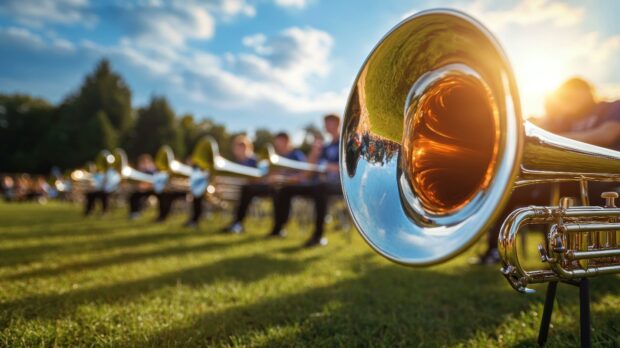Marching bands are a spectacle of synchronized artistry, blending music, movement, and visuals into performances that captivate audiences and celebrate teamwork. Whether on a football field, in a parade, or during a high-stakes competition, these ensembles showcase a remarkable combination of precision and creativity. At the heart of every successful marching band is an unwavering commitment to discipline and collaboration, which transforms individual musicians and performers into a cohesive, awe-inspiring unit. Brendan Geier of Madison, New Jersey, an experienced band director, highlights how the art of precision is both a science and a passion, embodying the dedication required for excellence in this field.
The Foundation of Music
Music is the heartbeat of every marching band. From the booming power of brass instruments to the rhythmic complexity of the percussion section, the music creates an emotional connection with the audience. Unlike a concert band, a marching band’s music must also serve as a functional element, guiding performers through intricate formations and transitions. This dual purpose demands arrangements that are not only melodically engaging but also adaptable to the unique challenges of outdoor performance.
The selection of music plays a pivotal role in defining a marching band’s identity. Directors often choose pieces that resonate with both the performers and the audience, balancing tradition with innovation. Whether adapting a classical symphony or a contemporary pop hit, the music must be meticulously arranged to ensure it retains its integrity while meeting the demands of a moving performance.
Choreography in Motion
Movement is where the art of marching bands truly comes alive. Performers are not merely musicians; they are also dancers and athletes, executing complex choreography while playing their instruments with precision. The drill, or the visual design of a performance, is carefully crafted to enhance the impact of the music. Each step, turn, and pivot is meticulously planned to create visual effects that amplify the emotional resonance of the soundtrack.
The physical demands of marching band performances cannot be overstated. Performers must maintain perfect posture, manage breath control, and execute precise movements—all while navigating formations that can involve hundreds of individuals. Rehearsals focus not only on mastering the music but also on achieving uniformity in every aspect of movement, from foot placement to the angle of a horn.
Visual Design and Storytelling
In addition to music and movement, visuals play a crucial role in the artistry of marching bands. Flags, props, and costumes add layers of meaning to a performance, transforming the field into a stage where stories are told without words. Color guard members, in particular, serve as the visual interpreters of the music, using flags and other props to enhance the narrative.
Thematic cohesion is essential to creating a memorable performance. Directors and designers work together to ensure that every element, from the choice of colors to the timing of visual effects, aligns with the overarching concept. This attention to detail elevates marching band performances from mere entertainment to immersive works of art.
The Role of Leadership and Collaboration
Behind every flawless performance is a team of dedicated individuals who have spent countless hours honing their craft. Directors, drum majors, and section leaders play critical roles in guiding and motivating the ensemble. Their leadership ensures that every member understands their part in the larger whole, fostering a sense of unity that is essential for success.
Collaboration is the cornerstone of a great marching band. Performers must not only master their individual roles but also remain acutely aware of their place within the group. This requires an extraordinary level of communication and trust, as even the smallest deviation can disrupt the intricate patterns and timing of a performance.
The Emotional Impact on Performers and Audiences
For the performers, marching band is more than just an extracurricular activity—it is a transformative experience. The discipline, teamwork, and resilience required to succeed in this demanding art form instill values that extend far beyond the field. Many participants describe their time in marching band as a defining chapter of their lives, filled with moments of triumph, camaraderie, and personal growth.
Audiences, too, are deeply affected by the power of marching band performances. The combination of stirring music, dynamic movement, and striking visuals creates an emotional resonance that lingers long after the final note. Whether it’s the pride of a community rallying behind their local band or the awe of witnessing a championship-level performance, marching bands have an unparalleled ability to inspire and unite people.
The Evolution of Marching Bands
Over the years, marching bands have evolved to reflect changes in both music and culture. Traditional military-style formations have given way to more fluid and dynamic designs, allowing for greater creativity and expression. Innovations in technology, such as wireless microphones and advanced lighting effects, have expanded the possibilities for what a marching band performance can achieve.
Despite these advancements, the core principles of marching band remain unchanged. Precision, dedication, and a passion for excellence continue to define this unique art form, ensuring its enduring appeal for generations to come.
The Legacy of Marching Bands
Marching bands hold a special place in the cultural fabric of many communities, serving as ambassadors of tradition and creativity. Their performances are a celebration of human potential, showcasing what can be achieved through hard work, collaboration, and a shared love of music.
As marching bands continue to push the boundaries of what is possible, they remind us
of the power of precision and artistry to bring people together. Whether experienced on the field, in the stands, or as part of the band itself, the magic of marching bands is a testament to the enduring value of music, movement, and visuals in our lives.
